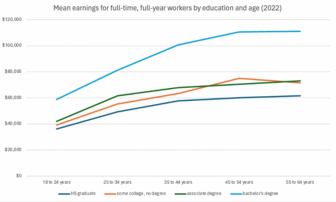
By and large across Michigan and the country community college completion rates are quite low. As detailed in Redesigning America’s Community Colleges this largely is a result of how community colleges are designed. For ease of access, not completion.
Redesigning America’s Community Colleges, as we have explored previously, lays out a detailed playbook on how to redesign a community college for completion. It has two central components: greatly enhanced and mandatory student advising combined with enhanced students supports and moving from cafeteria style course offerings to courses organized into guided pathways.
In this post I want to explore what advising and student services redesign looks like and the results community colleges are getting when they do that kind of redesign. The gold standard for this kind of redesign is CUNY’s Accelerated Study in Associate Programs (ASAP).
MDRC found that, six years after enrolling in a participating CUNY community college, 63.6 percent of first-time freshmen ASAP participants earned either a two-year or four-year degree compared to 43.3 percent in the control group. The B.A. obtainment rate after six years was 26.9% for the treatment group (where the treatment ended when they transferred to a four-year institution) compared to 18.1% in the control group.
The CUNY program was so successful that MDRC partnered with three Ohio community colleges to replicate ASAP. As described by MDRC in a new evaluation report the Ohio program involved:
The Ohio Programs model (based closely on CUNY ASAP) was designed to address multiple potential barriers to student success simultaneously and to address them over three full years. The model as originally planned included the following components:
Student Support
• Advising. The programs would offer comprehensive advising from an adviser with a small caseload (about 125 students). Students were required to visit their advisers twice per month in the first semester and as directed based on need thereafter.
• Tutoring. The programs would require students to attend tutoring if they were taking developmental (remedial) courses, on academic probation, or identified as struggling by a faculty member or adviser.
• Career services. The programs also would require students to meet with a campus career services staff member or participate in an approved career services event once per semester.Financial Support
• Tuition waiver. The programs would provide a tuition waiver that covered any gap between financial aid and college tuition and fees.
• Monthly incentive. The programs would offer a monthly incentive in the form of a $50 gas/grocery gift card, contingent on participation in program services.
• Textbook voucher. The programs would provide a voucher to cover the costs of textbooks.Course Enrollment
• Blocked courses and consolidated schedules. Seats would be held for program students in specific sections of courses during the first year.
• First-year seminar. New students would be required to take a first-year seminar (or “success course”), ideally with other program students, covering topics such as study skills and note-taking.Requirements and Messages
• Full-time enrollment. The programs would require students to attend college full time during the fall and spring semesters and encourage students to enroll in classes in the summer.
• Taking developmental courses early. The programs would encourage students to take developmental courses early in their time in college.
• Graduation within three years. The programs would encourage students to graduate within three years.
The results? Like CUNY ASAP a substantial increase in both graduation rates and the proportion of students transferring to a four-year university. Three- year graduation rates of 35 percent compared to 19 percent for the treatment group. And 18 percent of the treatment group transferring compared to 12 percent of the control group.
What about subgroups? MDRC writes:
Effects were estimated for several subgroups of students. Of particular interest were effects for subgroups of students with different levels of academic preparation, specifically students who did and did not have developmental education requirements when they entered the study. The program led to increases in degree receipt for students with developmental education requirements that were about the same size as the increases for those without these requirements. The original CUNY ASAP study focused only on students with developmental requirements, so the finding here for students with developmental requirements replicates those results and shows that the program model worked in this new setting for students who were less prepared academically. But the findings for students without developmental requirements confirm that more academically prepared students can also benefit from these types of services and support.
Effects were also explored for several other subgroups of students, defined by college, gender, race, age, and whether a student had a high diploma or equivalent, etc. For all the subgroups examined, the estimated effects on three-year graduation rates were large, positive, and statistically significant, demonstrating that the program is effective for a variety of students.
What about costs? MDRC reports:
The direct cost of the programs was $5,521 per program group member over three years, or $1,840 per year. This estimate includes $2,369 for administration and staffing, $1,517 for student services, and $1,635 for financial support. In total, after adding in the costs of educating more students (since the programs increased enrollment and the number of college courses taken), the colleges invested $8,030 more per program group member than they did per control group member. However, that investment also led to a large increase in degree receipt. Thus, the cost per degree earned for program group students was 22 percent lower than the cost per degree earned for control group students.
I know 35 percent doesn’t sound so impressive. It still means that nearly two-thirds of the Ohio community college ASAP participants didn’t graduate in three years. But it is a substantial increase over 19 percent. And at a relatively low cost.
So the immediate question for both policymakers and community college administrators is “why don’t we immediately implement the ASAP strategy for all community college students?”. And for that matter for non-selective four-year colleges as well. It is likely that these programs and services would substantially increase their graduation rates as well.
That still leaves on the to do list the much harder guided pathways redesign work. If we are serious about substantially increasing college completion rates that too is essential. But it sure seems like it is far past time to make ASAP a feature for all students in every Michigan college and university.







